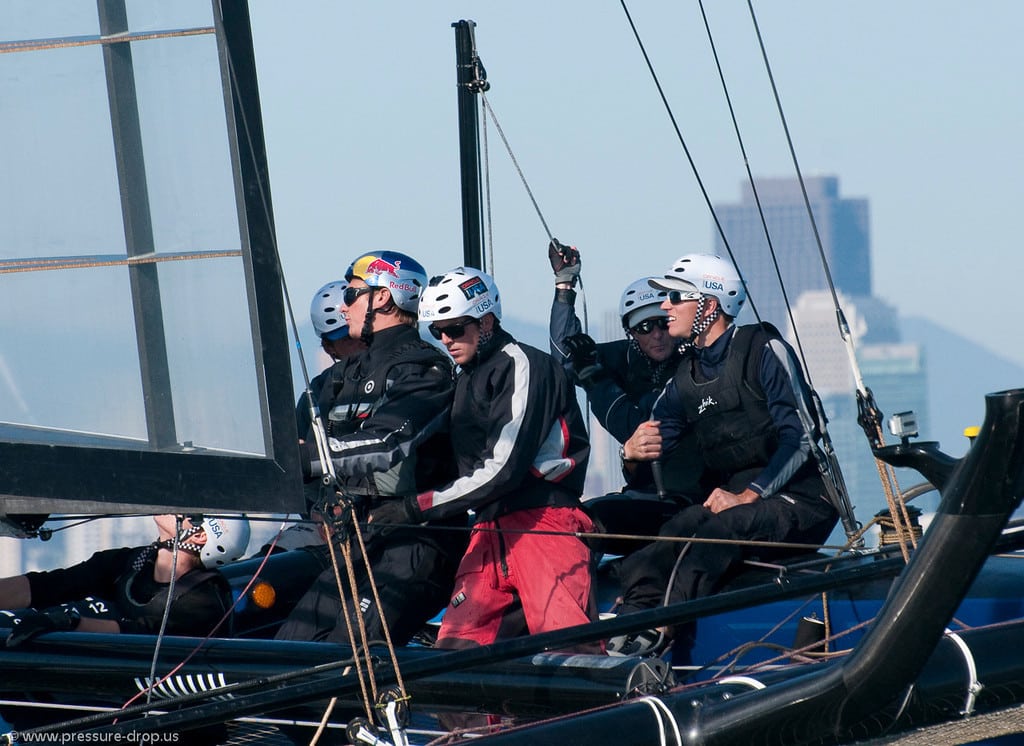
American Youth Sailing Force
Selected by Oracle Team USA to represent San Francisco in the Red Bull Youth America’s Cup, the seven members of the American Youth Sailing Force are still pinching themselves that they’re potentially on the road to an America’s Cup career. For the first time there’s a path for youth sailors 24 and under to sailing’s pinnacle event, and this west coast-based team is ready with huge amounts of energy and passion. Team members are Ian Andrewes, 23, David Liebenberg, 21, Michael Menninger, 23, Tommy Pastalka, 22, Matt Pistay, 22, Mikey Radziejowski, 21 and Evan Sjostedt, 19.
How did you get to the American Youth Sailing Force?
Evan: We saw the press release that announced the Youth America’s Cup. Ian was really excited about doing it, and we came up with the idea to start this team. I was excited about the same goal and thought we could go pretty far with this. We met with Tommy, and he joined us pretty early on and a few other local guys–Mikey and David–and it’s grown from there.
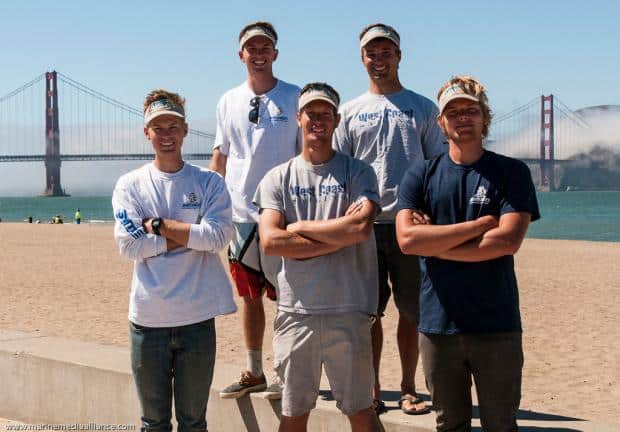
Left to right: Evan, Tommy, Ian, David, Mikey. Photo: Erik Simonson
You guys didn’t know each other going into this?
Ian: I knew David when we were younger, and then Evan and I met sailing skiffs in Seattle. It was calling a lot of people to see who would work out well for the team. We wanted keen, dedicated people to take the next step forward, which for us was organizing a team that gathered in San Francisco this past summer. We met in Richmond, sailed a lot, and did a lot of teamwork stuff. That was a really strong experience for us and helped us all come together, not just on the water but off the water–hanging out to see how we each felt about working as a team together.
What was the intrigue with the America’s Cup?
Ian: I’ve always been into it, even as a kid. It’s the pinnacle of sailing, and that’s the case for guys like us. That’s the reason we’re in the position we’re in–because we’re really dedicated to the sport.
Evan: For me, getting up at 3 a.m. to watch the America’s Cup in Australia with my Dad–it was one of those things I was really into.
What’s your combined racing experience?
Evan: Our strength is that we have such a broad range of experience between all of us. Most of us started in skiffs: 14s, 18s, Moths, and 49ers. That’s a big part of it because those boats translate pretty well to the cats. At the same time, a lot of us are sailing Melges 24s and 32s, doing TP52 stuff, and a bunch of offshore sailing.
Is there any Olympic experience on your team?
Ian: Speaking for the group, we’ve gone in a different direction with our sailing than the Olympic route. For some, that’s the only way that you can take sailing to the next level. Everyone on our team has gone the professional route, as far as getting on bigger boats, team programs, etc.
Tommy: That’s how special this opportunity is as far as having an alternate route besides the Olympics. It brings out a lot of the talent that may not otherwise be found in the United States.
Why do you think you won the selection series?
**Evan: **Compared to every other team out there, we had the most sailing together on the most relevant boats, like the skiffs and some bigger cats. That was a huge step for our team to have had that time sailing together. We had also spent a lot of time watching as much AC45 video footage as we could. When we hopped on the boat, we knew where the lines ran, we knew where to sit for different positions. We didn’t feel completely lost – that was a big thing.
Ian: When we got the call from Oracle about the selection, they let us know that we had made a presence there and how strong we were as a group and worked together to accomplish fairly normal tasks.
Had you spent any time on the AC45 going into the trials?
Ian: No. In the morning we did a bit of a briefing then spent the next few hours getting the boat rigged up and launched. We had two coaches riding with us–Darren Bundock rotating out with a few of the other guys. So it was trial by fire in a way, but it wasn’t too windy. They were really good about just letting us figure it out and seeing how we did as a team and how we directed ourselves.
Have special rules been developed for you to race the AC45s?
Evan: It’s not too different to the America’s Cup World Series; we’ll be racing on the same courses, and it’ll all be fleet racing. The biggest change is that we’re allowed six people on the boat instead of five–on average we’re a bit lighter than the Cup guys. That has a huge impact on how we handle the boat. It’s still a full-on difficult boat to sail, but one person makes a big difference, and it makes things faster. The extra set of hands is critical if someone needs some relief and you can rotate out.
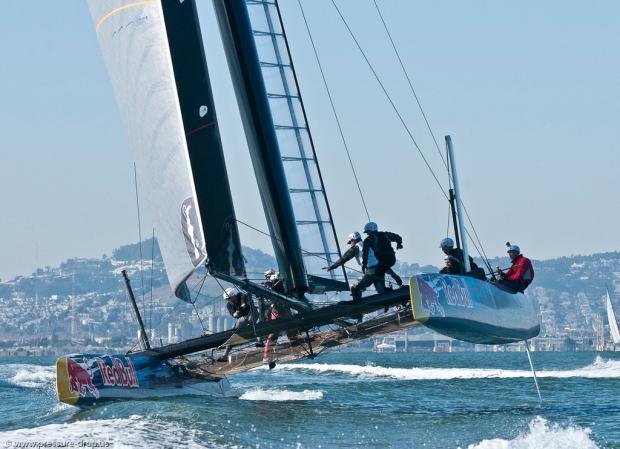
AYSF during the selection trials. Photo: Erik Simonson
What time will you get training on the AC45s?
**Ian: **We won’t have access to the 45 again until the beginning of March. It looks like we’ll be able to rig up the 45 two or three times a month after that and go sailing for a few days. A lot of the time in between will be spent just being at Pier 80, having access to the coaching with Philippe Presti, working on the boats onshore, working out at the gym there.
What kind of budget will you need?
**Ian: **Currently our total fiscal goal is $125K–that is the minimum but should cover everything. The rules are that we can’t be paid for this as sailors, so right now it’s on a Corinthian basis. Most of the money will go to ACRM for entry fees, insurance, and damage deposit because we’re essentially chartering the AC45s.
**
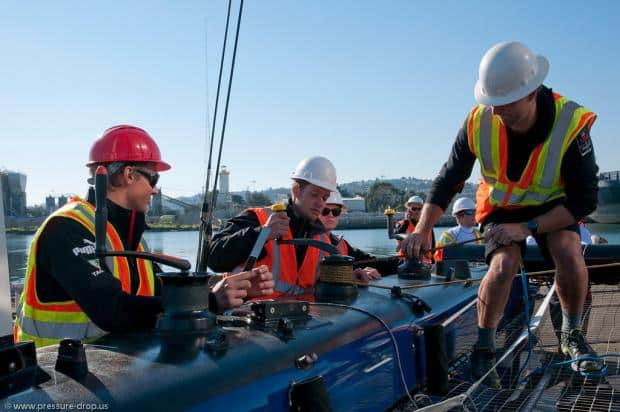
**AYSF rigs up the AC45. Photo: Erik Simonson
What’s your initial reaction to handling the AC45?
**Tommy: **It’s quite a lot of work! One of the important things is going to be focusing on our fitness, our stamina and strength. We all knew it was going to be hard work sailing the boat and spent a lot of time in the gym to get ready for this trial period but even so, it was pretty exhausting, and we have a lot of work to do. But once sailing, it was all pretty smooth, and the boat’s set up pretty simply so the main thing for handling the boat will be getting a little heavier, particularly for me, and then improving our strength and stamina to be able to get the boat around the course two or three times a day. Otherwise, it was an exciting experience, and the acceleration is incredible. There’s nothing like doing 26 downwind in 10 knots of wind. It was exciting even just leaving the dock and feeling the acceleration!
**
What assistance are you getting from Oracle Team USA?
**
**Ian: **As much as we can relative to what can be fit in with their AC72 schedule. But we’ll have access to all the onshore and offshore coaching and technology. The coaching was a big thing for us during the trials. However many hours we would spend on the water, we would then almost double that with time spent in the meeting room watching the GoPro footage and going over every tack afterwards: what was good, what we need to work on. It was huge to have that time dissecting everything we’d done on the boats. We’ll also have access to the gym and physical training at Pier 80.
A big part of the selection trials–on the morning of the second day they put us through a really rigorous fitness test. What was cool about it was that it was the same test that they give to their sailors. In just 5 minutes the test puts you pretty much to the edge of what you can do; it’s insane. It showed you exactly what you would need to do to be on an America’s Cup team. The guys are world-class athletes, and so in a sense we were being compared to the best of the best. It made a difference just seeing the hours that the guys put in at the gym outside of the sailing. The fact that they can work so hard and keep going throughout the day, their stamina is really impressive.
How did you come up with your team name?
**Ian: **That was the first hurdle; we figured we couldn’t go forward until we had a team name–you need an identity. We ended up writing down a whole bunch of words that we wanted to incorporate into the team, and we whittled that down and came up with American Youth Sailing Force. We really like the ‘Force’ part. We thought we may change later but it seems to be sticking pretty well. Evan came up with the logo and graphic design, which has turned out really well … there’s talk of team tattoos …
What’s the ruling regarding your ISAF category to participate?
**Ian: **There are no rules regarding your ISAF category as far as the sailing goes. They just don’t want us being paid for this event, so we can’t get a title sponsor who would pay us. It doesn’t mean we can’t make money in other ways, it just mean we can’t directly get paid to sail. There’s no conflict with other sailing work that we may be doing other than the time commitment to this, which of course is huge … but we’re definitely available otherwise! The point of this is that they’re trying to find the best young sailors, it’s a scouting opportunity for Oracle. It also gives us something past the Youth America’s Cup to work toward. This isn’t an end game for us.
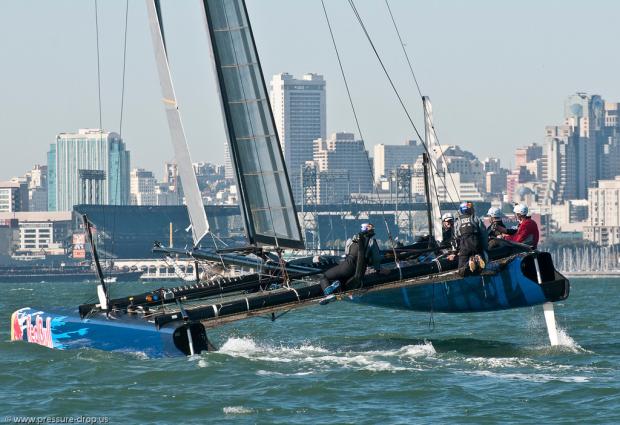
Photo: Erik Simonson
What’s your association with Red Bull?
**Evan: **We don’t deal with them at all but we’re stoked – everyone has seen the kind of stuff Red Bull does. The idea that sailing can be held in the same light and they’re working hard to do that is cool. It’s a good sign for sailing that Red Bull wants to get involved, especially in the United States and with the direction that the America’s Cup is going with the multihulls and making it exciting and available to a more mainstream audience. We’ve all got excited about some Red Bull related event at some point, right?









